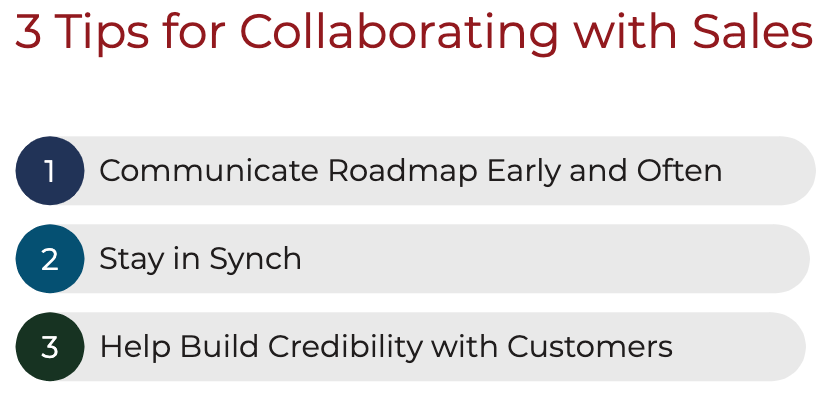 Collaboration is a critical skill for product managers, and in this post, I interviewed Juan Thurman, a fellow Austinite who has held leadership positions in sales, marketing and customer success at the likes of of B2B giants Twilio and IBM. He offered 3 tips for product managers as they think about working with their sales teams:
Collaboration is a critical skill for product managers, and in this post, I interviewed Juan Thurman, a fellow Austinite who has held leadership positions in sales, marketing and customer success at the likes of of B2B giants Twilio and IBM. He offered 3 tips for product managers as they think about working with their sales teams:
1. Communicate the Roadmap Early and Often
Juan's Tip
Make sure you have a steady and continuous cadence with your sales teams. Not only about features, expected benefits and roadmap, but also how product/feature decisions are made. In particular how you think about company strategy vs needs of customers.
When selling international SMS connectivity, we had a customer who wanted more routes and was upset at our perceived slow time table. When the PM talked to our customer and shared our strategy around security and quality of routes to ensure a good customer experience, their perception changed. They understood the time it took for sourcing, testing and integrating into the product.
Rajesh's Take
I love this example, because it highlights how many customers might see product development as a black box. By being open and transparent on why something is going to take a long time, you can shine a light on the process and build confidence in the product as well.
Internally, having a regular cadence of checkins with sales and customer success is a great way to get feedback from prospects and customers alike. If you don't have at least a monthly meeting with sales and customer success, set it up now. One thing I liked to do is keep a Google Doc asking them to share their top 3 product requests, with a few notes on the rationale / source. During our check ins, we discussed each request and I would try to understand why they were high priority.
Lastly, note how Juan emphasized understanding how product decisions are made. If you don't have a standard prioritization framework you use and can explain to your stakeholders, check out the 3 roadmap buckets we use with Vision-Led Product Management:
- Strategic progress (towards the vision)
- Optimizations (to the existing product)
- Product hygiene (ex. technical stability)
Making it clear what percentage of product development capacity is reserved for Optimizations such as customer feedback requests is helpful because no individual salesperson knows what other requests you're considering. Show them what other optimizations you're considering, let them know how many of them you can take, and rationalize why you chose the ones you did. Doing this will ensure you're not creating a "black hole of feedback" but rather responding to their feedback requests and building trust with them.
2. Stay in Synch
Juan's Tip
Making sure your sales team and key customers are aware and buy into your roadmap is important. It is more important that everyone understand how realistic vs aggressive the goals are and which features are prioritized.
We had a large customer that needed new features to meet their expansion and customer experience goals. PM guaranteed 9 months to execution and the customer agreed to stay on and wait. After 9 months without the agreed to features, the sales team was sent in to apologize profusely. The customer waited 3 more months and then left taking substantial amount of revenue.
Rajesh's Take
There's no faster way for PMs to erode trust with customers and internal stakeholders than promising feature delivery dates and missing deadlines. Instead, consider using a date-free roadmap to communicate the relative prioritization of product changes and doing regular product demos to show progress and solicit feedback from internal stakeholders, customers and prospects. When you do need to commit to a timeline, consider asking design and engineering to make a joint commitment with you to your stakeholder so they don't feel like you're "signing them up" for deadlines.
Also, building on the last tip of communicating often, make sure your sales team knows the status of roadmap items, and that you are providing them with the message to convey to prospects and customers, or communicating directly with those external stakeholders yourself.
Finally, don't forget to do your market research in situations like this and have a clear sense of what outcome the customer is trying to achieve. Think about whether their feature request is the best way to achieve that outcome, given the unique perspective you have hearing what other customers are experiencing. As PMs, we have to find the highest leverage use of design and engineering's time, and building one-off features is rarely that.
3. Help Build Credibility with Customers
Juan's Tip
One of the hardest, most important tasks in sales is to build credibility with customers. Many customers/buyers have been mislead, mistreated or lied to by vendors in the past. They are rightfully wary when presented with new solutions, new products, new players and new relationships. PM’s can leverage their expertise and knowledge to build credibility in a way that Sales cannot.
I was in the process of selling an identity and access management solution to a large multinational oil and gas company. We had been selected as a finalist. The customer shared with me that he was concerned that they would buy our solution and then have to buy a different and incompatible physical security solution. I told him I would research his concern and get back to him. During my research, I spoke to our security PM and shared the situation. I brought him in and discovered he was part of a working group to address the stated issue and we had integrations with leading physical security vendors on our short term road map. This satisfied our customer and we won a large software and services deal. Had I, (as Sales) just shared this information with the prospect the impact would have been lessened.
Rajesh's Take
Note how Juan wasn't aware of physical security integrations being on the short-term roadmap (see Tip #1). As I talked more to Juan about this one, what he mentioned was that it was at a large organization with hundreds of products, where he didn't have the time to keep up with every product roadmap, and where product didn't always share detailed roadmaps.
In this case, the PM was able to provide much more detail and richness about the physical security integrations and that's what helped win the customer over. As SaaS PMs, we need to remind customers that there's a whole team of people working hard to constantly improve the product. It's easy for them to forget this because they only see the UI or hear from colleagues how the product is working. So make sure you have regular face time with your customers to build trust and remind them of the team behind the scenes.
Closing Thoughts

This is just one of the many stakeholders product management must collaborate with, but it's an important one because without Sales it's nearly impossible for B2B products to succeed. We're planning to do more of these with some of the other functions product interfaces with in the future.


